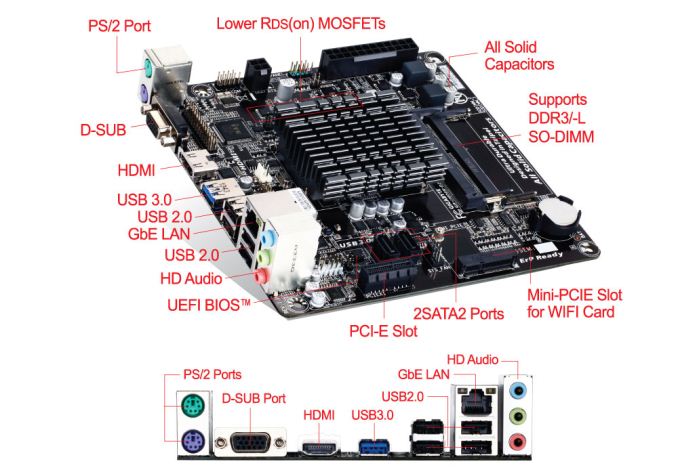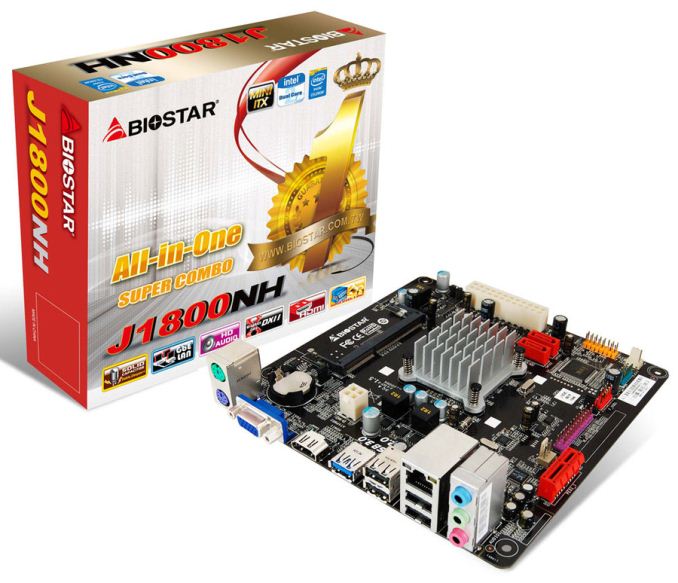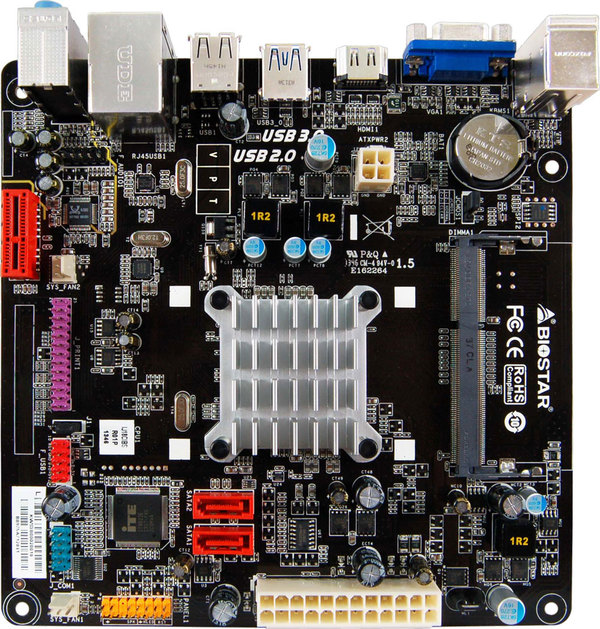10W Bay Trail-D Coming To Market from GIGABYTE and Biostar
by Ian Cutress on February 4, 2014 10:36 AM EST- Posted in
- Motherboards
- CPUs
- Biostar
- Gigabyte
- Fanless
- Silvermont
- SoCs
- Bay Trail

News on the grapevine is filtering down for Bay Trail-D. We have had the 20W Avoton server equivalent processor in our offices for a little while now, but alongside this Intel have 10W consumer based Celerons to market. With the chips being a ball-grid-array arrangement it is up to the motherboard manufacturers to provide the base on which these processors sit. Alongside some display from MSI at CES, GIGABYTE and Biostar are coming to market with their versions.
From GIGABYTE, this is the J1800N-D2H, using the 10W Intel Celeron J1800 Bay Trail-D SoC, a dual core Silvermont CPU starting at 2.41 GHz with turbo up to 2.58 GHz. N in the name indicates mini-ITX, and D2H positions the motherboard at the lower end in terms of specifications. The board itself uses a passive heatsink to cool the CPU (more than understandable for 10W), two DDR3L SO-DIMM 1333 MHz slots (1.35V memory only), a D-sub and HDMI audio output, two PS/2 ports, USB 3.0, a USB 2.0 hub, two SATA 3 Gbps ports, a PCIe 2.0 x1 slot, a mini-PCIe slot, Realtek ALC887 audio and Realtek NIC, all in a 17cm square form factor.
The Biostar J1800NH is a similar product with the Celeron J1800 SoC, using instead a single DDR3L SO-DIMM slot, fewer USB 2.0 ports and a Realtek ALC662 audio codec instead.
What is perhaps more surprising is the pricing. The Biostar motherboard is currently available for $56 with a $60 MSRP – the GIGABYTE motherboard, and the MSI one at CES, should be around $60 as well. However this SoC, sold by Intel, is listed as $72 tray price (i.e. in batches of 1000). This means either that these manufacturers are getting them at a discount, or selling them at a loss.
The purpose for Bay Trail-D is tablet like performance in a desktop form factor, with perhaps the added advantage of expandability and connectors. Users wanting quad core solutions will have to keep eyes peeled for J1850/J1900 versions, or jump to Pentium J2850/J2900. We saw that ECS was going to release a line of these motherboards last year. As mentioned, we have Avoton in to test, specifically Intel’s 8-core Silvermont solution for IPC/servers. Keep your eyes peeled for that review.
Sources: Fanless Tech via Liliputing via Tech Report.

















55 Comments
View All Comments
DARBYOTHRULL - Tuesday, February 4, 2014 - link
I wonder how well this would work as a Steam streaming box. It can't run SteamOS due to a 64 bit requirement, but it can run Linux/Windows.Vepsa - Tuesday, February 4, 2014 - link
I'm more thinking the Gigabyte as a small storage server. Cut the end of the PCIe slot out & populate it with a SATA/SAS card (from the pics it looks like it will have no problem with at least an 8x card fitting in) and put a mini-PCIe SATA card in for more storage. Then add 8GB of RAM,some HDDS & boot FreeNAS off a thumb drive and it should do fairly well.The_Assimilator - Tuesday, February 4, 2014 - link
Rather get a PCIe x1 extender and cut the end off that, that way you don't void the warranty on the board.This CPU/board is looking very promising for a fileserver. I'd like to see some performance numbers though, especially against the current cream of the low-end crop, the G465. I have one of the latter and it's slow as molasses (probably mostly due to the single physical core) so anything that feels more responsive is better in my books.
ddriver - Tuesday, February 4, 2014 - link
With 2 S-ATA - very unlikely, plus there are atom boards dedicated to such workloads, like this one: http://www.asrock.com/server/overview.asp?Model=C2...Octa core atom, 12 S-ATA, dual gigabit lan, 64 gigs of ram max and even a x8 PCI-E slot. This is a server board, those boards in the article are good for living room media boxes and nothing else.
BMNify - Tuesday, February 4, 2014 - link
thats true ,i found them to be around £300 +VAT for the octacore but its a shame Intel do not include their generic AVX/2 blocks in all their cores today so there's no incentive to actually optimize all the apps you would run there for far better SIMD data throughput or id try them today, at least Linaro are optimizing all the apps one by one for NEON SIMD as standard, we shall see what happens this year with their 64bit coresddriver - Tuesday, February 4, 2014 - link
I think atom still has SIMD, just not as wide and capable as those of the desktop and laptop cores, but that's the price you pay for better power efficiency. Something comparable to the previous (current market) generation of NEON.And at any rate, at a data server, you'd rarely need to crunch that much data, especially considering hardware on-board encryption/decryption, hashing, packet offloading and such are usually present. Obviously this is a narrow market, much more narrow than 1 or 2 CPU servers and workstations, which come with all AVX bells and whistles and even possibly multiple phi.
BMNify - Tuesday, February 4, 2014 - link
i would hold much potential in the phi just yet even if you have a need for32x 8 bit integer
16x 16 bit integer
8x 32 bit integer
4x 64 bit integer
plain 256 bit as per current AVX2 and its assumed they will double these for their 512bit AVX3.1
the generic current CoreLink CCN-508 NOC can deliver up to 1.6 terabits of sustained usable system bandwidth per second with a peak bandwidth of 2 terabits per second (256 GigaBytes/s) at processor speeds scaling all the way up to 32 processor cores total..... at least on paper
Intel's Knights Landing Xeon Phi due in 2015 with its antiquated QPI interconnect and its expected ultra short-reach (USR) interconnection only up to 500MB/s data throughput seems a little/lot short on real data throughput by then, Intel seem to need to go to Wide IO/HMC and a far better ultra short-reach interconnect to their GDDR5 high latency ultra short-reach (USR) ram ASAP it seems....
http://www.theregister.co.uk/2013/06/17/intel_knig...
"Intel is not saying precisely what processor socket the future Knights Landing chip will slip into, but the most obvious one is the socket shared by the Xeon E5 of the time. All that Hazra would confirm was that the idea is to deploy 14-nanometer processes to cram more transistors onto the Knights Landing chip and to get around some of the bottlenecks with the PCI-Express 3.0 bus that current coprocessors of any kind are adversely affected by."
"He would not discuss if memory for the future Xeon Phi would link in over the QuickPath Interconnect or by some other means, but he did say that Intel would be stacking the memory onto the processor package and that Knights Landing would have "leadership compute and memory bandwidth".
so again that would probably be HMC style 2.5D
DanNeely - Tuesday, February 4, 2014 - link
QPI is not an antiquated bus just because it was only used in a single generation of consumer parts prior to bringing the north bridge onto the CPU itself. It's still used on Xeon's released this year as the multi-socket interconnect bus.BMNify - Tuesday, February 4, 2014 - link
in your opinion, sure, however calling http://www.chiphell.com/data/attachment/forum/2012...2 QPI interconects giving a max total throughput of just 51.2 GB/s, and Intel restructuring the platform in such a way that the on board network interface controllers will now be wired to the PCI-Express so called by PR "root complexes" of the processors, rather than the chipset so as to try and remove some of that traffic from interfering with the core antiquated interconnects.
BMNify - Tuesday, February 4, 2014 - link
calling 2 QPI interconects giving a max total throughput of just 51.2 GB/s not antiquated in 2014 for the best Intel have in generic x86 server land (never mind retail) seems odd when you consider that LSI Axxia® 4500 Family of ARM SOC NOC (network On Chip) gives you upto 256 GigaBytes/s